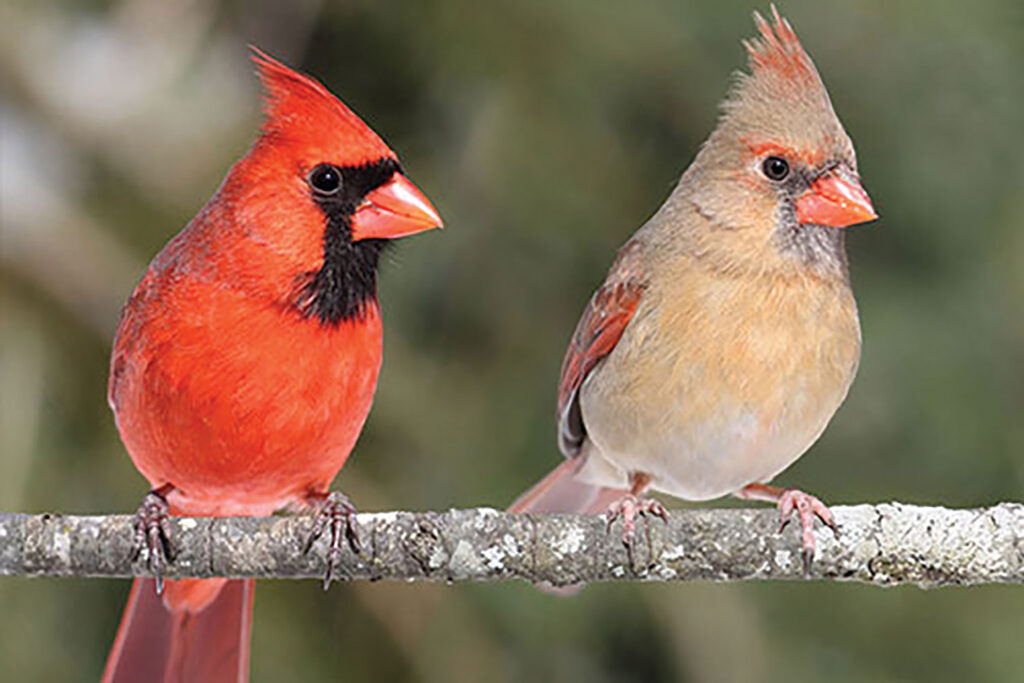Backyard Birds
By Amber Mabe
My cat has a spot by the window where she watches the birds at our feeder. She will spend hours lazing in the sun, watching the birds play and eat, and I often find myself joining her. Watching these energetic little creatures and listening to their songs is a soothing pastime for millions of people, and for good reason. Having a bird feeder can boost mental health and a sense of well-being, just from connecting with nature in this small way. Putting out a feeder is something we can do with our children to teach them about the creatures that share our living space and develop a love and respect for nature. Feeding the birds is a symbiotic relationship: while we find joy in watching, our feeders allow birds to more easily feed their young and survive harsh weather. Whether you are a seasoned birdwatcher, or someone who is interested in learning more about the feathered friends in your backyard, here are some of the most common visitors to backyard feeders and some fun facts you might not know about them.
Chickadee
Brave and friendly, chickadees will often be the first visitors to your backyard feeders. With their prominent black cap and bib, and familiar chick-a-dee-dee-dee call, it is hard to miss these agile little birds. If you watch carefully, you will see them grab a sunflower seed, then fly to a place where they can place the seed between their toes and crack it open with their beak to get to the soft insides. Chickadees have been known to save food for later and can remember thousands of hiding places!
Tufted Titmouse
Often seen flocking with chickadees is their only slightly more timid cousin, the tufted titmouse. This little grey bird uses its crest of feathers on top of its head to show aggression, sometimes bullying each other over first rights at the feeder. Sunflower seeds are a favorite of these birds, who will shell them first and save them for later somewhere nearby. Titmice love to use hair for nesting and have been known to pluck hairs from living animals and even humans.
Northern Cardinal
Our state bird, with its bright red plumage, is always a welcome visitor to any home feeder. Though not picky eaters, Cardinals love black sunflower seeds. You will often see a mated pair visit the feeder, the male’s bright red in stark contrast to the rusty brown of the female. During mating season, you might see the male offering seeds to his partner. The female Cardinal is one of the only female songbirds who sings, and mated pairs will even sing a duet. If you have any berry-producing plants in your yard, they may become home to a family of Cardinals this spring.
White-Breasted Nuthatch
If you live near the woods, you might have already seen this agile little bird hopping up and down tree trunks with no regard for gravity. Not to be confused with the Chickadee, Nuthatches have a black cap only and a long beak used for probing into bark for bugs or digging into suet for their favorite treats. Nuthatches also have an extra-long hind claw that allows them to perch upside-down on trees and feeders alike. You might notice them wedging seeds into cracks in tree bark, either to crack them open or save them for later.
Red-Bellied Woodpecker
A suet feeder is almost guaranteed to attract woodpeckers in wooded areas, and if a Red-bellied Woodpecker comes to visit, you will not miss it. Almost as striking as its bright red head and striped back is its loud call. You will often hear these woodpeckers before you see them. They may be the largest birds that come to your suet feeder, and love to vocalize while they eat. These birds have a tongue that can reach almost two inches past the tip of their beaks, and the barbed tip helps to grab onto bugs deep in the bark of a tree. If you live near a nest of young fledglings, you can sometimes see them playing and chattering, darting in and out of the trees.
To make your own backyard suet feeder, check out the link on our website.



